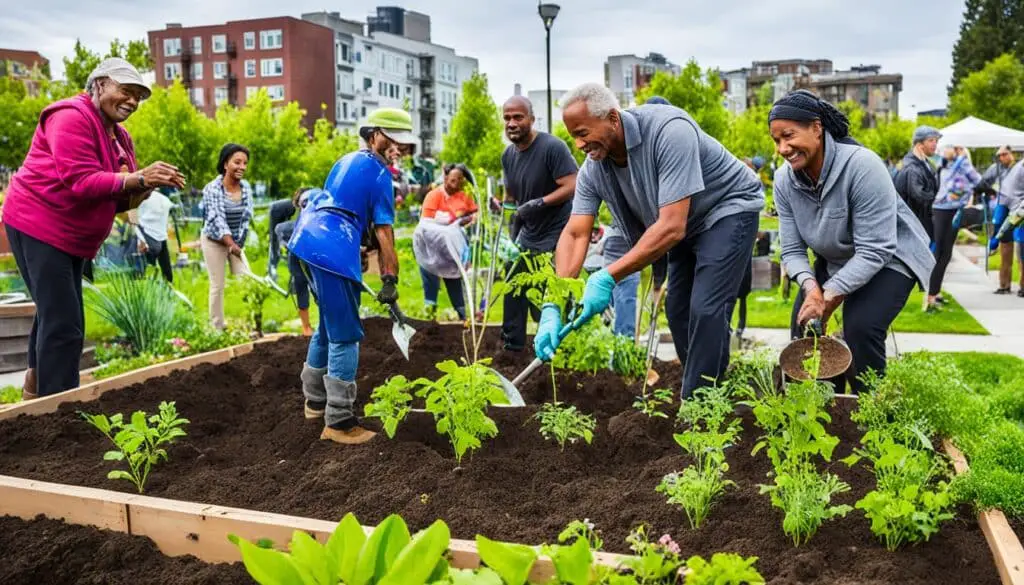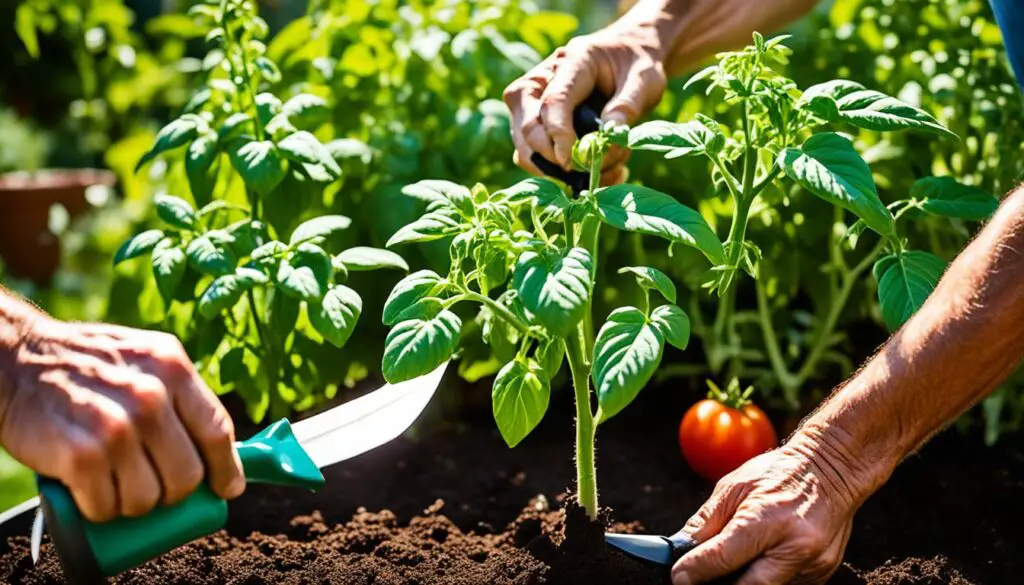Starting a community garden is an impactful way to utilize vacant spaces and create a flourishing green oasis in the heart of your urban environment. By bringing people together and fostering a sense of community, community gardens not only beautify neighborhoods but also provide numerous benefits to residents. In this article, I will guide you through the essential steps to start a community garden and transform your cityscape into a vibrant and sustainable haven.
Key Takeaways:
- Community gardens convert unused spaces into thriving green areas.
- Starting a community garden requires careful planning and support from the community.
- Choosing a suitable location with access to sunlight and good soil quality is crucial.
- Engage local residents, businesses, and organizations to gather support and volunteers.
- Create a well-designed layout with raised beds and efficient irrigation systems.
Choosing the Perfect Location
The first step in starting a community garden is finding the perfect location. A community garden needs a space that is accessible, receives adequate sunlight, and has fertile soil. Look for vacant lots or underutilized spaces in your community that hold the potential to be transformed into beautiful garden areas. By repurposing these spaces, you not only create a green oasis but also contribute to revitalizing the neighborhood.
When selecting the location for your community garden, consider the following factors:
- Accessibility: Choose a location that is easily accessible to residents of all ages and abilities. It should be centrally located and well-connected with public transportation.
- Sunlight Exposure: Ensure that the chosen space receives ample sunlight throughout the day. Most vegetables and flowers require at least six hours of direct sunlight for healthy growth.
- Soil Quality: Assess the soil quality of the potential garden site. Conduct a soil test to determine its pH level and nutrient content. If the soil needs improvement, consider using raised beds or container gardening to create the ideal growing conditions.
Additionally, it’s crucial to obtain permission from the landowner or relevant authorities to use the space for a community garden. Check if there are any necessary permits or agreements that need to be obtained beforehand.
“Choosing the right location for your community garden sets the foundation for its success. A well-planned garden in an accessible space ensures that more people can participate and benefit from urban gardening.” – Sarah Gardner, President of Urban Gardening Society
By carefully selecting the perfect location, you can create a community garden that brings people together and promotes sustainable urban gardening practices.
The Benefits of Choosing an Ideal Location
When you choose an ideal location for your community garden, you unlock a multitude of benefits for both individuals and the neighborhood as a whole:
- Improved access to fresh, locally grown produce
- Enhanced community engagement and connection
- Increased urban biodiversity
- Beautification of vacant lots and underutilized spaces
- Education and skill-building opportunities
A community garden becomes more than just a patch of green. It becomes a place where individuals can connect with nature, build relationships, and learn about sustainable gardening practices.
Gathering Community Support
Building a community garden requires the support of the community. Engage with local residents, schools, businesses, and organizations to gather support for your project. Community involvement is crucial in ensuring the success and sustainability of your garden.
Start by reaching out to local residents and informing them about your community gardening initiative. Spread the word through community newsletters, social media platforms, and local events. Encourage individuals to get involved and share their ideas.
Moreover, involve local schools and universities to engage the younger generation in the project. Collaborate with teachers to integrate gardening into the curriculum, offering educational programs and workshops for students to learn about sustainable practices and the benefits of gardening.
Businesses and organizations can also play a significant role in supporting your community garden. Approach local businesses for sponsorship opportunities, seeking funding or in-kind donations for necessary supplies and equipment. Establish partnerships that align with your garden’s mission and values, fostering a sense of community and collaboration.
“A community garden is not just about growing plants; it’s about nurturing relationships and fostering a sense of belonging.” – Sarah Green, Founder of Green Thumb Community Garden
Recruiting volunteers who are passionate about gardening and community involvement is essential in ensuring the smooth operation of your community garden. Create a volunteer program where individuals can contribute their time and skills to maintain the garden, organize events, and offer assistance to fellow community members.
Fundraising is another critical aspect of building a successful community garden. Organize fundraising events such as plant sales, garden tours, or community gatherings to raise funds for ongoing maintenance and expansion. Seek grants and sponsorships from local foundations and organizations that support community initiatives.
Benefits of Community Involvement
The involvement of the community in your garden project brings numerous benefits. It fosters a sense of ownership, making community members feel invested in the success and maintenance of the garden. It creates opportunities for social interaction, allowing individuals to connect and build relationships with fellow gardeners and neighbors.
Furthermore, community involvement promotes knowledge sharing and skill development. People with different levels of experience and expertise collaborate, exchanging gardening tips and techniques, and learning from one another. This continuous learning process leads to personal growth and the creation of a supportive gardening community.
| Benefits of Community Involvement in a Community Garden | Examples |
|---|---|
| Promotes social interaction and community bonding | Regular gardening events and workshops |
| Fosters a sense of ownership and responsibility | Neighborhood volunteers taking care of the garden |
| Encourages knowledge sharing and skill development | Expert gardeners mentoring beginners |
| Creates a sustainable and self-sufficient gardening community | Seed and plant swapping within the community |
By involving the community from the start, you can harness the collective power of individuals coming together to create something beautiful and impactful. Community gardens not only enhance the physical environment but also nurture a sense of belonging, well-being, and pride within the neighborhood.
Designing the Garden Layout
A well-designed layout is essential for the success of your community garden. When planning the garden, it’s important to consider factors such as the size of the garden, the types of plants you want to grow, and the needs of the community.
One effective design element to incorporate is raised beds. Raised beds offer several benefits, including improved drainage, reduced weed growth, and easier access for gardeners. They also provide defined spaces for different types of plants, making it easier to manage and cultivate a variety of crops.
Another crucial aspect of garden design is the installation of an irrigation system. This system ensures proper and efficient watering of plants, reducing the time and effort required for maintenance. With an irrigation system in place, water is delivered directly to the root zone of plants, minimizing wastage and promoting healthy growth.
Creating communal areas within the garden is also important. These spaces can serve as gathering places for community members, facilitating social interaction and educational activities. Whether it’s a picnic area, a shaded seating arrangement, or a designated spot for workshops, these communal areas foster a sense of community and enhance the overall experience of the garden.
Lastly, aesthetics play a crucial role in creating a welcoming environment for everyone. Consider incorporating elements such as colorful flowers, decorative features, and pleasant pathways to enhance the visual appeal of the garden. By paying attention to the design details, you can create a space that is not only functional but also a joy to be in.
Garden Layout Design Tips:
- Plan the layout based on the size of the garden and the types of plants you want to grow.
- Incorporate raised beds for improved drainage, weed control, and accessibility.
- Install an irrigation system to ensure proper watering and reduce maintenance.
- Create communal areas for community gatherings and educational activities.
- Prioritize aesthetics to create a visually appealing and welcoming environment.
| Garden Design | Raised Beds | Irrigation Systems |
|---|---|---|
| Allows for effective space utilization and organization. | Makes gardening more accessible and manageable. | Ensures proper watering and reduces maintenance. |
| Provides defined areas for different types of plants. | Promotes improved drainage and reduced weed growth. | Delivers water directly to the root zone, minimizing wastage. |
| Enhances the visual appeal of the garden. | Offers opportunities for creative landscaping. | Facilitates healthy plant growth and lessens manual watering. |
Cultivating and Maintaining the Garden
Once your community garden is established, it’s important to cultivate and maintain it properly. Providing gardening education and resources to community members is crucial in ensuring the success of their individual plots.
Here are some essential gardening tips to help you care for your plants and maintain a thriving community garden:
Gardening Tips
- Choose the right plants for your garden based on the local climate and soil conditions.
- Plant at the appropriate times of the year to maximize growth and yield.
- Ensure proper spacing between plants to allow for healthy growth and avoid overcrowding.
- Water your plants regularly and adjust the watering schedule based on weather conditions.
- Use organic fertilizers and compost to provide essential nutrients to your plants.
- Implement mulching to conserve moisture, suppress weed growth, and regulate soil temperature.
- Regularly monitor your plants for signs of pests or diseases and take appropriate action to prevent damage.
- Practice crop rotation to reduce disease and pest problems and maintain soil fertility.
Plant Care
Proper plant care is essential for the health and productivity of your garden. It involves various tasks such as pruning, staking, and supporting plants as they grow.
“Pruning encourages healthy growth and improves the overall appearance of your plants. Remove dead or diseased branches, and trim back overgrown foliage.”
Garden Maintenance
Regular garden maintenance is key to keeping your community garden in top shape. Create a maintenance schedule that includes tasks like weeding, watering, and pest control.
“Weeding helps prevent competition for nutrients and reduces the risk of pests and diseases. Regularly remove weeds from your garden beds to keep them healthy.”
Engaging the community through events, workshops, and workdays is a great way to encourage regular involvement and ensure the collective care of the garden. Together, we can nurture the garden and foster a sense of community, allowing our urban oasis to thrive.
Conclusion
Starting a community garden is a rewarding endeavor that not only beautifies vacant spaces but also brings numerous benefits to the community. These green urban oases provide opportunities for community engagement, promote sustainable living, improve food security, and enhance the overall well-being of residents.
Creating a community garden is a collaborative effort that fosters a sense of belonging and connection among neighbors. It encourages community members to work together, share knowledge, and build relationships. By nurturing these green spaces, we can create a more sustainable and resilient community.
A community garden not only offers a sanctuary of greenery in urban areas but also contributes to environmental conservation. By planting trees, flowers, and vegetables, we improve air quality, reduce the urban heat island effect, and enhance biodiversity in our neighborhoods.
Moreover, community gardens provide access to fresh, healthy food, especially in areas with limited grocery options. They empower individuals and families to grow their own produce, promoting food self-sufficiency and reducing reliance on unhealthy processed foods.
By following the steps outlined in this guide, you can make a positive difference in your neighborhood and create a thriving community garden for all to enjoy. Let’s work together to build a greener future, one garden at a time.
FAQ
What is a community garden?
A community garden is a shared space where individuals or groups come together to grow fruits, vegetables, flowers, or herbs. It is a place for community members to connect, learn, and enjoy the benefits of gardening.
Why should I start a community garden?
Starting a community garden has numerous benefits. It beautifies vacant spaces, promotes sustainable living, improves food security, and enhances the overall well-being of residents. It also provides opportunities for community engagement and creates a sense of pride in the neighborhood.
How do I choose the perfect location for my community garden?
When choosing a location, consider factors such as accessibility, sunlight exposure, and soil quality. Look for vacant lots or underutilized spaces in your community that have the potential to be transformed into beautiful garden areas. Ensure that you have permission to use the space and consider any necessary permits or agreements.
How can I gather community support for my community garden?
Engaging with local residents, schools, businesses, and organizations is key to gathering support for your project. Recruit volunteers who are passionate about gardening and community involvement. Seek partnerships and sponsorship opportunities to help with fundraising and acquiring necessary supplies. By involving the community from the start, you can create a sense of ownership and ensure the sustainability of your garden.
What should I consider when designing the layout of my community garden?
A well-designed layout is essential for the success of your garden. Consider factors such as the size of the garden, the types of plants you want to grow, and the needs of the community. Utilize raised beds to make gardening more accessible and manageable. Install an irrigation system to ensure proper watering and reduce maintenance. Plan for communal areas for gatherings and educational activities. Pay attention to aesthetics and create a welcoming environment for everyone.
How do I cultivate and maintain my community garden?
To properly cultivate and maintain your garden, provide gardening education and resources to community members. Implement a maintenance schedule that includes tasks such as weeding, watering, and pest control. Encourage regular community engagement through events, workshops, and workdays. By nurturing the garden and fostering a sense of community, your urban oasis will continue to thrive.



